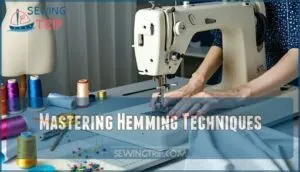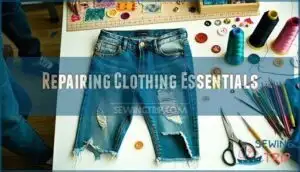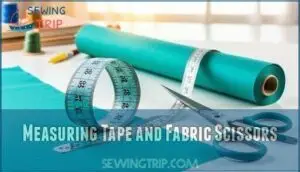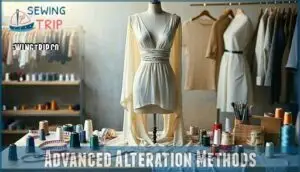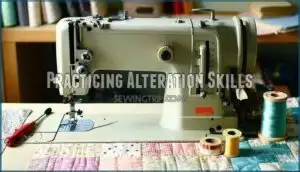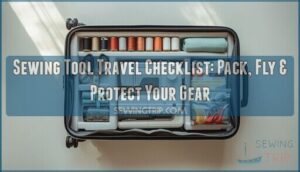This site is supported by our readers. We may earn a commission, at no cost to you, if you purchase through links.
 You’ll discover dozens of easy pattern alteration tutorials online that transform ill-fitting clothes into perfect pieces.
You’ll discover dozens of easy pattern alteration tutorials online that transform ill-fitting clothes into perfect pieces.
YouTube hosts thousands of step-by-step videos covering everything from basic hemming to complex waistline adjustments. Craftsy and Pinterest offer detailed guides with clear photos that break down tricky techniques.
These platforms let you pause, rewind, and practice at your own pace without spending money on classes. Professional seamstresses share insider secrets that typically cost hundreds to learn elsewhere.
Whether you’re shortening sleeves or taking in seams, these tutorials make alterations less intimidating. The real game-changer comes when you learn which measurements matter most for each garment type, and understand how to apply these skills to make perfect pieces with complex waistline adjustments.
Table Of Contents
- Key Takeaways
- Learning Pattern Alteration
- Sewing Alterations Basics
- Mastering Hemming Techniques
- Repairing Clothing Essentials
- Understanding Fabric Types
- Essential Sewing Tools
- Online Tutorials for Alterations
- Alteration Techniques for Beginners
- Advanced Alteration Methods
- Practicing Alteration Skills
- Frequently Asked Questions (FAQs)
- Conclusion
Key Takeaways
- You’ll find thousands of free pattern alteration tutorials on YouTube, Craftsy, and Pinterest that teach everything from basic hemming to complex waistline adjustments at your own pace without expensive classes.
- You can start with simple projects like hemming pants or sewing on buttons using basic tools you already have – measuring tape, fabric scissors, matching thread, and pins – before tackling more advanced alterations.
- You’ll save money and extend your wardrobe’s lifespan by learning essential techniques like taking in loose garments, letting out tight clothes, and adjusting seams and darts to transform ill-fitting pieces into custom fits.
- You should practice on scrap fabric first to build confidence and test different techniques before working on your actual clothes, starting with easy alterations and gradually progressing to more complex pattern modifications.
Learning Pattern Alteration
You’ll need basic sewing skills like measuring, cutting, and stitching before you start altering patterns to fit your body perfectly.
Master the fundamentals first—measuring, cutting, and stitching are your foundation for perfect pattern alterations.
These fundamental techniques help you understand how garments work together, so you can confidently adjust seams, darts, and hemlines to transform ill-fitting clothes into custom pieces.
Basic Sewing Skills Required
Before diving into pattern alteration tutorials, you’ll need foundation skills.
Master machine threading and basic hand stitching first.
Learn to identify different seam types and fabric materials.
Practice taking accurate basic measurements using a tape measure.
These sewing skills for beginners form the backbone of successful alterations.
Start with sewing tutorials for beginners to build confidence before tackling complex sewing techniques for beginners.
Alteration Techniques for Garments
Garment-fitting mastery starts with understanding key alteration techniques.
You’ll learn seam adjustments to reshape clothing, dart manipulation for better curves, and fabric grain awareness to maintain structure.
Waistband alterations expand or reduce sizes, while panel inserts add room where needed.
These sewing pattern adjustments form your foundation for any clothing alteration guide, making DIY pattern alteration achievable through easy pattern modification methods.
Sewing Alterations Basics
Success in sewing alterations starts with understanding the fundamentals that’ll transform your wardrobe.
Master the basics first—your wardrobe transformation depends on solid fundamentals, not fancy techniques.
Before you grab scissors or thread, you need solid groundwork in fit assessment and measuring techniques. These skills separate amateur attempts from professional-looking results.
Your alteration journey requires mastering these essential elements:
- Fit Assessment – Learn to identify where garments pull, gap, or hang incorrectly on your body
- Measuring Techniques – Use proper tools and methods to capture accurate body and garment measurements
- Alteration Types – Understand common modifications like taking in seams, letting out fabric, and adjusting lengths
Basic stitches form your foundation for all clothing alterations. Master the running stitch, backstitch, and slip stitch before tackling complex garment alteration projects.
Fabric knowledge helps you choose appropriate techniques for different materials. Easy pattern modification becomes achievable when you understand how fabric behaves and responds to various sewing alterations methods.
Mastering Hemming Techniques
You’ll master three essential hemming methods that work for any garment in your closet, from pants that drag on the floor to circle skirts that need a professional finish.
These techniques require no advanced sewing skills and use simple tools you probably already have at home, making them accessible to anyone looking to improve their sewing skills with simple tools.
Hemming Pants Without Sewing
You can hem pants without touching a needle or thread.
Iron-on hems and fusible webbing create permanent fixes that last through multiple washes.
Hemming tape works perfectly for quick clothing alterations, while fabric glue offers instant results.
Many people use iron-on hem solutions for crafting and clothing repair projects.
For temporary hems, try removable adhesive strips.
These no-sew methods save time and deliver professional-looking clothing repair results every time.
Using Bias Tape for Circle Skirts
Circle skirts present unique hemming challenges due to their curved edges, but bias tape makes this pattern alteration tutorial surprisingly manageable.
Bias tape types include single-fold and double-fold options that work perfectly for circle skirt fabrics. You can find various bias tape options online.
- Cutting bias strips at 45-degree angles creates flexible tape
- Attaching bias tape requires careful pinning around curves
- Circle skirt fabrics like cotton and rayon work best
- Finishing bias edges prevents fraying and adds durability
Banded Hem for Dresses
When your dress needs both length and style punch, banded hems deliver the perfect solution.
You’ll add a contrasting fabric strip to create visual interest while adjusting the hemline. Choose your band width carefully – wider bands make bold statements, while narrow ones add subtle elegance.
Discover various banded hem dresses online for inspiration. This pattern alteration tutorial transforms ordinary dresses into custom pieces through strategic band attachment and hem stabilization techniques.
Repairing Clothing Essentials
You’ll learn essential repair techniques that save your favorite clothes from the donation pile, including fixing holes in jeans, securing loose buttons, and adding decorative patches.
These straightforward methods help you extend your wardrobe’s lifespan while creating a trendy raw-edge look on cropped jeans without needing advanced sewing skills, using straightforward methods.
Fixing Holes in Jeans
Your favorite jeans don’t need to hit the trash bin when holes appear. Denim repair through invisible mending saves money and extends garment life.
Pattern alteration tutorials teach you strategic patch placement for knee reinforcement and hole prevention. These clothing repair techniques work better than buying new pairs every season.
- Small holes: Use darning technique with matching thread for nearly invisible fixes
- Large tears: Apply fabric patches from inside the jean for strong, lasting repairs
- Knee damage: Reinforce high-stress areas before holes develop into bigger problems
- Prevention tips: Check seams regularly and add internal patches to thin spots
Sewing on Buttons and Patches
Beyond mending holes, you’ll master sewing buttons and patches through pattern alteration tutorials.
Different button types require specific thread strength for durability. Match thread to fabric weight and secure with backstitch for clothing alterations.
Place decorative patches strategically using reinforcement techniques that prevent future tears. Practice patch placement on scrap fabric first – it builds confidence before tackling your favorite garments.
Cropping Jeans for Raw Edge Look
After mastering button repairs, you’ll love cropping jeans for that trendy raw edge look.
Start by measuring inseam length carefully, then use sharp DIY cropping tools for clean cuts.
Cut at a 45-degree angle for natural fraying. Non-stretch denim works best for this project.
Machine wash afterward to accelerate distressing techniques. These simple pattern adjustments create custom fits while adding raw edge styling to your wardrobe effortlessly.
Understanding Fabric Types
You’ll need to know your fabric types before you start any alteration project, since cotton behaves differently than polyester or wool when you cut and sew.
Understanding whether you’re working with natural fibers like cotton and linen or synthetic materials like nylon and spandex helps you choose the right techniques and tools for successful alterations.
Natural and Synthetic Fibers
Understanding fiber properties transforms your pattern alteration for beginners journey.
Natural fibers like cotton and wool offer breathability but require gentle care instructions, while synthetics provide durability and wrinkle resistance.
This knowledge helps you make simple pattern adjustments effectively.
- Cotton contains 90% cellulose for excellent breathability
- Polyester represents 55% of synthetic fiber production worldwide
- Sustainable fabrics biodegrade within 1-5 months naturally
Choosing Right Fabric for Alterations
When selecting fabric for pattern alteration techniques, consider fabric weight and fiber content first.
Heavy denim requires different clothing alterations than lightweight silk.
Check the stretch factor – knits need specialized pattern fitting adjustments compared to wovens.
Examine drape quality to predict how alterations will hang.
Color matching becomes essential when adding panels or inserts during how to alter patterns projects for beginners.
Working With Different Fabric Textures
When working with velvet, silk, or denim, you’ll need different approaches for successful alterations.
Heavy fabrics like wool require sturdy needles and pressing techniques that won’t crush the texture.
Lightweight materials need delicate seam finishes and gentle fabric drape consideration.
Match your needle selection to fabric weight, and always test pressing techniques on scraps before altering your garment.
Essential Sewing Tools
You’ll need the right tools to make pattern alterations work smoothly and look professional.
Start with a basic sewing machine, sharp fabric scissors, measuring tape, matching thread, and quality pins to handle most alteration projects successfully.
Sewing Machine for Beginners
Your first sewing machine doesn’t need to break the bank. Entry-level machines between $100-$300 offer everything you need for beginner pattern alteration projects.
Here’s your machine selection guide:
- Basic Operation – Choose mechanical models with 6-10 built-in stitch types for reliable performance
- Stitch Types – Look for straight, zigzag, and buttonhole functions to handle most alteration tasks
- Maintenance Tips – Select drop-in bobbin systems for easier threading and consistent tension
- Troubleshooting – Pick brands like Singer or Brother with strong customer support for beginners
Measuring Tape and Fabric Scissors
Quality tools make the difference between frustration and success in pattern alteration tutorial projects.
You’ll need a flexible measuring tape for tape accuracy and sharp fabric scissors for clean cuts.
Ergonomic scissors reduce hand fatigue during long cutting sessions, while proper scissor maintenance keeps blades sharp for precise fabric grain cuts.
| Tool Feature | Why It Matters | Pro Tip |
|---|---|---|
| Flexible Tape | Curves around body contours | Keep it straight for flat measurements |
| Sharp Scissors | Clean cuts prevent fraying | Use only on fabric, never paper |
| Ergonomic Design | Reduces hand strain | Test grip before buying |
These beginner pattern alteration essentials support effective cutting techniques and accurate clothing pattern modification.
Invest in quality tools—your pattern alteration techniques will improve dramatically with proper equipment that delivers consistent pattern alteration tips.
Having sharp scissors and a flexible measuring tape are crucial for success, and understanding the importance of ergonomic design can enhance your overall experience.
By following these guidelines, you can ensure a more enjoyable and productive pattern alteration process, leading to better cutting techniques and more accurate results.
Thread and Needle Selection
Match your thread types to your fabric—cotton thread for cotton fabrics, polyester for synthetics.
Needle sizes matter too: size 9-11 for lightweight fabrics, 14-16 for heavy materials.
Color matching doesn’t need perfection; choose one shade darker than your fabric.
Quality stitch results depend on proper fabric compatibility, and these sewing techniques and pattern alteration methods guarantee your clothing pattern modification projects succeed every time.
Online Tutorials for Alterations
You’ll find thousands of free alteration tutorials online that teach you exactly how to fix common fit problems with clear video instructions.
These step-by-step guides show you how to take in seams, adjust hem lengths, and modify patterns so your clothes fit perfectly without spending money on a tailor, using techniques that help you achieve a great fit.
Step-by-Step Guides for Alterations
Online pattern alteration tutorials break down complex techniques into manageable steps.
You’ll learn marking fabric accurately, seam ripping without damage, and making precise fitting adjustments.
These sewing tutorials cover pattern matching for professional results and proper pressing techniques.
Most platforms offer visual guides that adjust sewing patterns systematically, making pattern alteration online accessible for beginners seeking perfect fits.
Beginners should start with essential sewing supplies for smooth alterations, using online resources to guide them through the process of sewing tutorials.
Online Communities for Sewing Enthusiasts
Thousands of sewists gather in vibrant sewing communities where you’ll discover pattern alteration online resources that transform your skills.
Reddit’s r/sewing connects 500,000 members sharing alteration advice and project showcases. Facebook groups offer fabric sourcing tips while Pinterest provides sewing inspiration.
These platforms deliver skill development through pattern sharing, creating your go-to hub for sewing education and community support.
Alteration Techniques for Beginners
You’ll start your alteration journey by learning three basic techniques that fix most common fit problems: taking in loose garments, letting out tight clothes, and adjusting seams and darts.
These simple methods work on shirts, pants, and dresses, giving you the skills to transform clothes that don’t fit into pieces you’ll actually wear.
They are essential for adjusting seams and darts, which can make a significant difference in the fit of your clothes.
Taking in Garments for Better Fit
You’ve mastered finding tutorials – now it’s time to make those baggy clothes fit like they were made for you.
Taking in garments transforms oversized pieces into flattering favorites through simple pattern alteration methods.
Here’s your roadmap for garment alteration techniques:
- Marking Excess fabric with pins or chalk
- Strategic Seams placement for natural shaping
- Creating Darts to eliminate bulk areas
- Customized Fit through Balance Proportion adjustments
Letting Out Garments for More Comfort
Sometimes you need more room instead of less.
Letting out garments requires seam expansion techniques and panel insertion methods.
Start by examining existing seam allowances – you’ll find hidden fabric there.
Release stitches carefully, then add fabric panels if needed.
To accurately assess the potential for letting out seams, begin by measuring seam allowances.
These garment alteration techniques focus on comfort adjustments through strategic fabric manipulation, helping you gain those precious extra inches without compromising the garment’s structure.
Adjusting Seams and Darts
When your clothes feel tight or baggy, seam adjustments and dart manipulation can transform the fit completely.
These pattern alteration techniques help you achieve proportion balance while respecting fabric grain direction.
Here’s your roadmap to fit improvement:
- Mark problem areas – Pin excess fabric or tight spots while wearing the garment
- Adjust gradually – Make small changes to seams, testing fit between modifications
- Balance proportions – Maintain adjustments that keep the garment’s original silhouette and design intent
Advanced Alteration Methods
You’re ready to tackle complex pattern modifications that transform your sewing from basic fixes to custom creations.
These advanced methods let you redesign garments completely, work with intricate patterns, and turn outdated clothes into stylish pieces that fit your body perfectly.
Working With Patterns and Templates
Pattern grading and template customization transform your sewing game.
They make resizing simple through pattern alteration software.
You’ll learn drafting basics and pattern matching techniques that save time and money.
Start with basic templates, then advance to complex modifications.
| Pattern Tool | Best For | Skill Level | Time Needed |
|---|---|---|---|
| Digital Patterns | Quick resizing | Beginner | 15 minutes |
| Paper Templates | Precise drafting | Intermediate | 30 minutes |
| Pattern Software | Complex grading | Advanced | 45 minutes |
| Tracing Paper | Pattern matching | All levels | 20 minutes |
The use of digital patterns and pattern software can significantly enhance your sewing experience.
Creating Customized Garments
Once you’ve got patterns down, you’re ready to create garments that fit like they were made for you.
Start with simple pattern alteration tutorial projects that match your measurements exactly. This wardrobe customization approach gives you complete control over style expression and personalized fit.
You’ll transform basic sewing patterns into budget adaptation solutions while embracing sustainable fashion through thoughtful garment fitting techniques, leading to a more personalized and complete control over your wardrobe.
Refashioning Old Clothes Into New
Beyond simple alterations, refashioning clothes transforms your wardrobe into unique pieces. You’ll save money while creating sustainable fashion through creative reuse and style transformation.
Essential upcycling ideas include:
- Converting dresses into trendy skirts or tops
- Adding sleeves to sleeveless garments for versatility
- Combining multiple pieces for dramatic DIY clothing makeovers
For curve hemming, consider using a rolled hem to create professional finishes on lightweight garments. Pattern alteration tutorials online guide your wardrobe customization journey effectively.
Practicing Alteration Skills
You’ll build your alteration skills by starting with simple projects like hemming old towels or practicing seams on fabric scraps before working on actual clothes.
This approach lets you test different techniques and thread tensions without risking your favorite garments, giving you the confidence to tackle more complex alterations as your abilities improve.
Starting With Simple Projects
Your journey into beginner alterations starts with picking the right first project.
Skip complicated blazers and choose a simple hem on pants or a basic seam adjustment.
These foundational skills build your confidence without overwhelming you.
| Project Type | Difficulty | Time Needed | Skills Learned | Tools Required |
|---|---|---|---|---|
| Easy Hemming | Beginner | 15 minutes | Measuring, folding | Tape, pins, scissors |
| Button Repair | Beginner | 5 minutes | Hand stitching | Needle, thread, button |
| Patch Application | Beginner | 10 minutes | Fabric placement | Iron, patch, fabric |
| Simple Seams | Beginner | 20 minutes | Machine sewing | Sewing machine, thread |
| Basic Darts | Intermediate | 30 minutes | Shaping techniques | Pins, chalk, machine |
Foundational skills build your confidence without overwhelming you.
Building Confidence With Scrap Fabric
Everyone builds sewing confidence through practice on scrap fabric before tackling expensive garments.
Use remnants to test hemming techniques, practice seam adjustments, and experiment with different stitches. These scrap fabric uses help develop essential skills without fear of mistakes.
Start with simple alterations like shortening sleeves or adjusting waistbands. Each successful project provides a confidence boost for future pattern alteration services, which helps in developing essential skills.
Experimenting With Different Techniques
Once you’re comfortable with basics, try different stitch variations and seam finishes on practice pieces.
Mix dart manipulation techniques with various fabric combinations to see how they behave.
Test different closure options like zippers versus buttons.
Pattern alteration tutorials online show multiple approaches for the same problem.
A good pattern alteration course teaches you when to break the rules creatively to achieve a better outcome with pattern alteration.
Frequently Asked Questions (FAQs)
How do I learn pattern alteration?
Picture yourself transforming ill-fitting clothes into perfect pieces.
You’ll learn pattern alteration through online tutorials, practice on scrap fabric, take structured courses, and join sewing communities.
Start small, build confidence gradually, and master precise measurements.
How do I learn sewing alterations?
Start with basic hand stitches and hemming techniques on practice fabric.
Take online courses through Craftsy or YouTube tutorials.
Begin with simple projects like shortening pants, then progress to taking in seams and adjusting waistbands gradually.
This approach allows you to build skills and confidence in your sewing abilities, starting with the basics.
How to make a good alterations?
90% of homemade alterations fail due to poor measurements.
You’ll need sharp fabric scissors, measuring tape, and matching thread.
Measure twice, cut once. Pin carefully, press seams flat, and practice on scraps first.
What are pattern alteration skills?
Pattern alteration skills let you modify sewing patterns to fit your body perfectly.
You’ll learn to adjust length, width, bust, waist, and hip measurements.
These techniques transform ill-fitting patterns into custom-tailored garments that flatter your unique shape.
Can you learn garment alterations at home?
Like a master chef following a recipe, you can absolutely learn garment alterations at home.
Online tutorials, practice fabric, and basic tools make it achievable.
Start small, build confidence, and you’ll soon tailor clothes perfectly.
What is the quickest way to modify a pattern?
You’ll modify patterns fastest by making width adjustments at side seams and length changes at hem or waistlines.
These simple tweaks don’t require redrafting entire pieces, letting you customize fit quickly, with simple tweaks being the key to efficient modification.
How to alter a pattern for beginners?
Rome wasn’t built in a day, and neither are pattern skills.
Start with simple adjustments like shortening sleeves or hemming lengths. Practice on scraps first, then tackle darts and seams.
You’ll master basics before attempting complex alterations.
How can I learn pattern making easily?
You’ll master pattern making through online tutorials on Craftsy, YouTube, and Skillshare.
Start with basic blocks, practice on scrap fabric, and gradually tackle complex designs.
Consistent practice builds confidence faster than you’d expect.
What order do pattern alterations go in?
Before you telegraph your alterations, start with length adjustments first.
Then tackle width changes at the bust, waist, and hips.
Save detailed fit tweaks like darts and curves for last—it’s your roadmap to success.
What is the easiest sewing pattern to follow?
Start with simple A-line skirts or basic tote bags.
You’ll find straight seams, minimal shaping, and forgiving fits make these patterns perfect for beginners.
They teach essential skills without overwhelming complexity or tricky techniques.
Conclusion
Like Cinderella’s fairy godmother transforming rags into perfect attire, you’ll transform your wardrobe using easy pattern alteration tutorials online.
These digital resources give you the power to fix any fitting issue without expensive tailoring costs.
You’ll master essential techniques from basic hemming to complex waistline adjustments.
Start with simple projects and gradually tackle more challenging alterations.
With practice and patience, you’ll develop the skills to make every garment fit like it was custom-made for your body.



